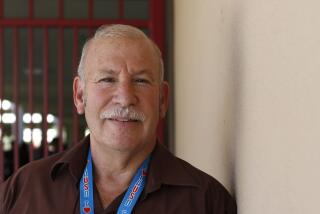‘You Have to Say: This Is Where I Believe We Can Go’
- Share via
Enter the campus of John Francis Polytechnic High School from the parking lot and you can’t help but notice striking examples of the leadership of principal Carolyn Rabb Burch.
To the left you’ll see geometric designs rendered by students in blue, yellow, red and orange; on the music building to the right, you’ll see portraits of Beethoven and a depiction of the school’s marching band. Keep walking across the 48-acre campus just off Interstate 5 in the northeast San Fernando Valley and you’ll encounter student murals at almost every turn, more than a dozen in all.
The first of the murals went up soon after Burch came to the school in 1993, and she says they send important messages.
“They say to students, ‘We value your work, we value your creativity,’ ” she said. The murals encourage teachers to be ambitious and innovative. And, to the community, “they say, ‘Come in, welcome.’ ”
Academics who study school leadership talk about the importance of symbols and of messages; they say that one of a principal’s biggest jobs is creating an atmosphere that values and celebrates learning and teaching.
“You have to see the big picture and you have to say: This is where I believe we can go,” Burch said.
But she said required college courses taught her little about how to do that. Instead, she said, she benefited from on-the-job training.
Now 55, she started out 33 years ago as a librarian. Later she was an English teacher, a program coordinator, a reading specialist, the district supervisor of English teaching, an assistant principal and finally a principal. She will retire at the end of this month.
Because of a shortage of candidates today, she said, people are moved into the job of principal too quickly and lack experience. Too few, she said, are able to be instructional leaders.
That requires an interest in and knowledge of teaching. A principal also has to know that his or her job is no more important than what teachers do. That’s why she accompanies her teachers to professional development sessions, it’s why she sits down with them to analyze students’ work. And it’s why she continues to teach herself, through Cal State Northridge.
But even though she works at least 12 hours a day, Burch said it has become harder and harder to carve out time for what clearly is a school’s main mission. A big issue is the sheer size of the school: 3,700 students on a campus built for 2,600. The school went to a year-round schedule a few years back, and still there are not enough classrooms. Burch was recently named secondary school administrator of the year by the local chapter of the Assn. of California School Administrators, recognizing the vast improvements she’s achieved at Poly. Still, she says, there’s much that remains to be done.
“They want you to do all these things and you don’t have the resources to do it,” she said. “It’s becoming almost like a thankless task.”
More to Read
Sign up for Essential California
The most important California stories and recommendations in your inbox every morning.
You may occasionally receive promotional content from the Los Angeles Times.













